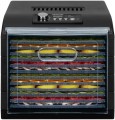Tray size
Horizontal dimensions of one dryer tray.
For round models, this paragraph usually indicates the diameter (for example, “Ø250”), for other cases — the length and width. Anyway, the information about the size allows you to estimate the total area and, accordingly, the capacity of the device. At the same time, note that a larger size affects the dimensions and weight of the structure, and also requires more heating power (ceteris paribus).
Temperature range
The temperature range that the dryer can provide in the working chamber.
The simplest models provide only one operating temperature option, usually from 50 °C to 60 °C. More advanced devices equipped with thermostats (see above) and can have a wide range of adjustment — this is very useful, because different temperature regimes are recommended for different products. To assess the general capabilities of a particular dryer, you can use the following table of temperatures recommended for drying:
— 35...40 °C — plant stems, greens;
— 40...45 °C — bread;
— 38...42 °C (in some cases up to 45 °C) — yoghurt;
— 50...55 °C — vegetables;
— 55...60 °C — fruits;
— 65...75 °C — meat, fish.
We emphasize that these are the most general, conditional data. The specific temperature may differ from the recommended one — depending on the thickness of the slices, the specific type of food, the desired result, etc. Detailed recommendations on this matter can be found in special sources.
Tray material
The material from which the complete trays of the dryer are made.
—
Plastic. Inexpensive, but at the same time very practical material. In terms of strength and overall reliability, the plastic is inferior to metal, however, during normal use of the dryer, this difference is not noticeable. In addition, if such trays are made in the form of complete compartments, their walls can be made transparent so that you can observe the contents without interrupting the process and without knocking down the temperature regime. However the transparent walls gradually become cloudy due to the low resistance of plastic to scratches — however, it takes a lot of time for this moment to become a serious inconvenience. Thus, most modern dryers use plastic trays.
—
Stainless steel. The main advantages of metal trays are strength and resistance to overheating. On the other hand, these advantages rarely turn out to be significant, and steel is more expensive than plastic. In addition, if metal trays are made in the form of separate compartments, they are opaque, and to check the condition of the products, you will have to open these compartments, lowering the temperature and disrupting the process. . For models with a rear fan (see above), this point is not relevant — they usually have a transparent door; however, such devices are not cheap. Thus, this tray material is rare nowadays — mainly among advanced dryers.

